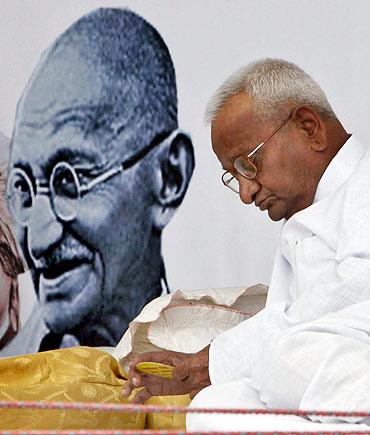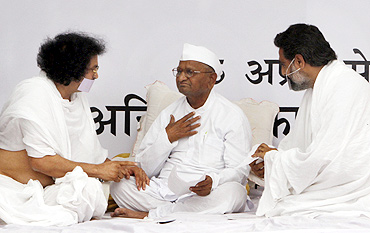Photographs: Parivartan Sharma/Reuters
Sunita Narain profiles the man who never took half steps to development and transformed a drought-hit village into a prosperous one back in the 1980s.
The first time I met Anna Hazare was in the mid-1980s. My colleague Anil Agarwal was travelling in search of answers to how India could regenerate lands and address desperate poverty.
We heard about a village, Ralegaon Siddhi, in the drought region of Ahmednagar. It was peak summer. We were led to a small temple where we were introduced to a diminutive man, who, we were told, was spearheading change in the village.
This was Kishan Baburao Hazare (Anna), a driver in the Indian Army, back to 'fix' his village.
...
Anna Hazare and his 80s revolution
Image: Anna Hazare is a GandhianPhotographs: B Mathur/Reuters
Anna Hazare explained that this was the start of the ridge-to-valley model -- rain would be trapped in the trenches, slowing the flow of water to recharge groundwater. Then, trees would be planted and grazing stopped; and the hills would be the catchment for the village's water endowment.
He then took us to see a series of check-dams on the streams, ponds in fields and percolation dams in the valley. The principle was the same: Hold the rain where it falls and use water to build the economic base of the village.
Anna Hazare and his 80s revolution
Image: Hazare rests during his recent campaignPhotographs: Parivartan Sharma/Reuters
And the returns were high. Incomes had risen, so that over a quarter of the village earned more than Rs 5 lakh annually (this was a time when the super-rich in India were defined as those who earned more than Rs 10 lakh annually). Most importantly, income disparities were low.
Anna Hazare and his 80s revolution
Image: Yoga guru Swami Ramdev speaks with social activist Swami Agnivesh as Anna HazarePhotographs: B Mathur/Reuters
The first thing he did was to ban alcohol. He stopped television viewing and insisted that all residents contribute to community labour.
He started a school, where the only qualification for admission was that the student had to be a dropout. Every student excelled. He was not willing to take half steps to development.
Anna Hazare and his 80s revolution
Image: Hazare with men from the Jain communityPhotographs: B Mathur/Reuters
I would not say that the scheme, with its many prohibitions, was a hit in the modern and free society of rural Maharashtra. But I would definitely argue that Anna Hazare's Ralegaon Siddhi remains a pilgrimage for all to understand the potential of a new model, where ecological and natural wealth can create well-being and economic growth. The village has become the basis of planning across the country. This is no small change.







article